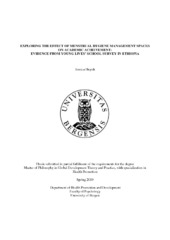| dc.description.abstract | Background: Ethiopian schools require improved school environments in order to improve educational outcomes. Evidence suggests that a lack of sanitation spaces, specifically private areas to for girls to change and manage menstruation hygienically, comfortably, and with dignity, leads to school absenteeism, distraction, and disengagement. Objective: The objective of the study was to explore the effects of menstrual hygiene management (MHM) spaces (a private place to wash menstrual rag and/or a place where female student can wash themselves privately) on math and English achievement scores and the extent in which environmental factors at the individual- , home-, and school/community levels can help explain those differences. Data and Methods: 3844 adolescent girls, between the ages of 14 and 19 years, from the Young Lives 2016-2017 Ethiopian School Survey were included in the study. Math and English test scores were measured at Wave 1 to Wave 2. To account for the change in scores across time and the effect of MHM spaces on math and English scores, a mixed between-within subjects analysis of variance (ANOVA) was used. A mixed between-within subject analysis of covariance (ANCOVA) was used to assess the effects of MHM spaces on math and English scores while accounting for individual- , home-, and school/community factors. Results and Discussion: The study found evidence that the availability of MHM spaces had a significant, yet very small effect on performance of math and English achievement tests in unadjusted analysis. However, adjusting for individual-, home-, and school- level covariates removed the effect between MHM spaces and achievement scores that were found in unadjusted analysis. While the potential effects of MHM spaces on achievement tests in this study are small, other individual, family, and school characteristics measured in this study were found to be more important. Conclusion: This study examined MHM spaces and its impact on academic achievement. Though an important first step, providing MHM spaces does not, on its own, enable education for girls to fulfill its transformative potential. The potential for improving the Ethiopian girls’ education requires comprehensive consideration and interventions that operate on various environmental levels found in the ecological framework. Further research may expand on the findings of the study by improving the methodologies which include using direct menstruation data, consideration of the quality of MHM spaces, and the use of multilevel linear modeling analyses. | en_US |
